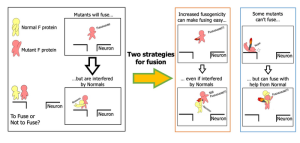This illustration provides a 3D graphical representation of a spherical-shaped, measles virus particle that is studded with glycoprotein tubercles. Those tubercular studs colorized maroon, are known as H-proteins (hemagglutinin), and those colorized gray are referred to as F-proteins (fusion). The F-protein is responsible for fusion of virus and host cell membranes, viral penetration, and hemolysis, and the H-protein is responsible for binding of virus to cells. Both types of proteinaceous studs are embedded in the envelope’s lipid bilayer. [CDC/ Allison M. Maiuri, MPH, CHES. Illustrator: Alissa Eckert]
Researchers in Japan have uncovered the mechanism for how the measles virus (MeV) can cause subacute sclerosing panencephalitis, or SSPE, a rare but fatal neurological disorder that can occur several years after a measles infection.
Although the normal form of the measles virus cannot infect the nervous system, the team found that viruses that persist in the body can develop mutations in a key protein that controls how they infect cells. The mutated proteins can interact with its normal form, making it capable of infecting the brain. The team, headed by Yuta Shirogane, MD, PhD, Assistant Professor at Kyushu University’s Faculty of Medical Sciences, hopes that the results will help scientists develop therapeutics for SSPE, as well as elucidate the evolutionary mechanisms common to viruses—such as novel coronaviruses, and herpesviruses—that have similar infection mechanisms to measles.
Shirogane and colleagues reported their findings in Science Advances, in a paper titled “Collective fusion activity determines neurotropism of an en bloc transmitted enveloped virus.”
Although people born after the 1970s may have received a measles vaccine as a child, World Health Organization estimates suggest that nearly nine million people worldwide were infected with measles in 2021, with the number of deaths reaching 128,000. Measles is caused by an enveloped RNA virus of the Morbillivirus genus, and remains one of the most contagious pathogens. MeV may persist in the brain, causing a fatal progressive neurological disorder SSPE several years after acute infection. The incidence of SSPE is estimated to be approximately four to 11 cases per 100,000 cases of measles. “Despite its availability, the recent COVID-19 pandemic has set back vaccinations, especially in the Global South,” commented Shirogane. “SSPE is a rare but fatal condition caused by the measles virus. However, the normal measles virus does not have the ability to propagate in the brain, and thus it is unclear how it causes encephalitis.”
A virus infects cells through a series of proteins that protrude from its surface. Usually, one protein will first facilitate the virus to attach to a cell’s surface, then another surface protein will cause a reaction that lets the virus into the cell, leading to an infection. So, what a virus can or cannot infect can depend heavily on the type of cell. “Usually, the measles virus only infects your immune and epithelial cells, causing the fever and rash,” pointed out Shirogane. “Therefore, in patients with SSPE, the measles virus must have remained in their body and mutated, then gained the ability to infect nerve cells. RNA viruses like measles mutate and evolve at very high rates, but the mechanism of how it evolved to infect neurons has been a mystery.” As the scientists further noted, “RNA virus populations generally evolve rapidly under selection pressures, because of the high error rates of viral RNA polymerase. This viral evolvability is known to cause some of the difficulties in controlling RNA virus infections, such as drug resistance, immune evasion, and expansion of the tropism and host range.”
The key player in allowing the measles virus to infect a cell is its fusion protein, or F protein. “MeV has two kinds of glycoproteins on its envelope, the hemagglutinin (H) and the fusion (F) proteins,” the authors noted. “The H protein binds to receptors on the human cells and subsequently triggers the conformational changes of the trimeric F protein from the prefusion form to the post fusion form, leading to virus-to-cell or cell-to-cell membrane fusion.”
The team’s previous studies had shown that certain mutations in the F protein put it in a ‘hyperfusongenic’ state, allowing it to fuse onto neural synapses and infect the brain. For their newly reported study, the team analyzed the genome of the measles virus from SSPE patients and found that various mutations had accumulated in their F protein. Interestingly, certain mutations would increase infection activity while others actually decreased it.
“This was surprising to see, but we found an explanation,” continued Shirogane. “When the virus infects a neuron, it infects it through ‘en bloc transmission,’ where multiple copies of the viral genome enter the cell. In this case, the genome encoding the mutant F protein is transmitted simultaneously with the genome of the normal F protein, and both proteins are likely to coexist in the infected cell.”

Based on their hypothesis, the team analyzed the fusion activity of mutant F proteins when normal (wild type; WT) F proteins were present. Their results showed that fusion activity of a mutant F protein is suppressed due to interference from the normal F proteins, but that interference is overcome by the accumulation of mutations in the F protein.
In another case, the team found that a different set of mutations in the F protein results in a completely opposite result: a reduction in fusion activity. However, to their surprise, this mutation can actually cooperate with normal F proteins to increase fusion activity. “In this study, we show that mutations accumulated in SSPE derived MeV F genes dynamically change the F protein fusogenicity,” they stated.
Thus, even mutant F proteins that appear to be unable to infect neurons can still infect the brain. “A mutant F protein having SSPE-derived substitutions exhibits lower fusogenicity than the hyperfusogenic F protein containing some of those substitutions, but by the wild-type F protein coexpression, the fusogenicity of the former F protein is enhanced, while that of the latter is nearly abolished.”
Shirogane stated, “It is almost counter to the ‘survival of the fittest’ model for viral propagation. In fact, this phenomenon where mutations interfere and/or cooperate with each other is called ‘Sociovirology.’ It’s still a new concept, but viruses have been observed to interact with each other like a group. It’s an exciting prospect.”
The authors further commented, “ … this study provides important insights into the evolutionary process of MeV neuropathogenicity and genotype-phenotype relationships of oligomeric viral fusion proteins in viral evolution …” They acknowledged that further studies will be needed to further understand the mechanisms. “The concept of en bloc transmission could unveil positive and negative interactions among different fusion proteins in other enveloped viruses … we suggest that the interpretation of mutations found in en bloc transmitted viruses requires careful evaluations, because the effects of mutations depend on interactions between different viral genomes … Whether mutations in the H gene also contribute to the MeV neurotropism is not known.”
“There are many mysteries in the mechanisms by which viruses cause diseases,” Shirogane stated. “Since I was a medical student, I was interested in how the measles virus caused SSPE. I am happy that we were able to elucidate the mechanism of this disease.”